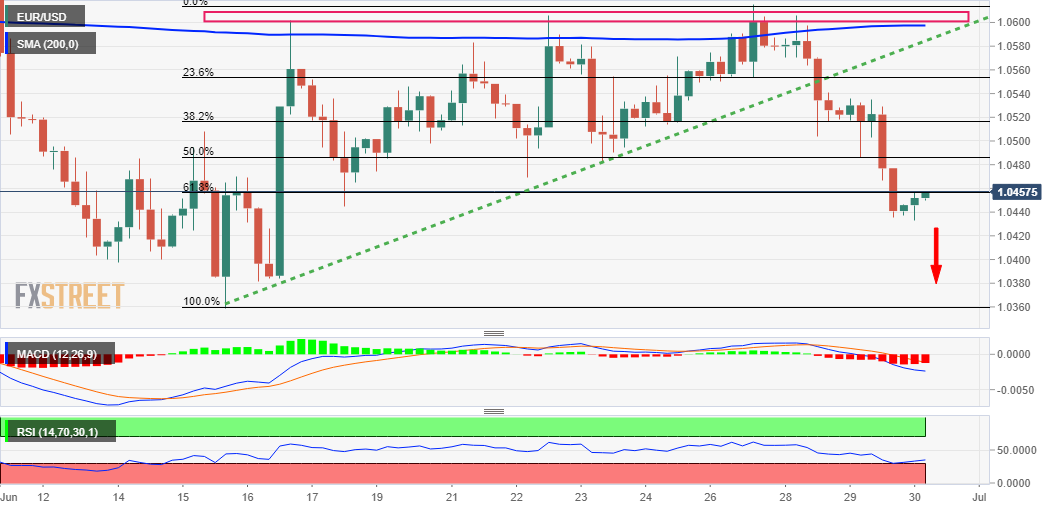- A combination of factors dragged EUR/USD to a nearly two-week low on Wednesday.
- Softer German CPI print weighed the shared currency amid broad-based USD strength.
- Powell’s hawkish remarks and the risk-off impulse provided strong lift to the greenback.
The EUR/USD pair extended the previous day's rejection slide from the 50-day SMA – levels just above the 1.0600 mark – and witnessed heavy selling for the second successive day on Wednesday. The downward trajectory dragged spot prices back below mid-1.0400s, or a nearly two-week low, and was sponsored by a combination of factors. The shared currency was undermined by softer German consumer inflation figures, which, along with a strong pickup in the US dollar demand, exerted downward pressure on the major.
According to the preliminary estimate, inflation in the euro area's largest economy surprised to the downside and the Harmonised Index of Consumer Prices (HICP) declined to the 8.2% YoY rate in June. This marked a notable deceleration from the 8.7% in May and was also well below expectations for a reading of 8.8%. Adding to this, European Central Bank President Christine Lagarde, speaking at the central bank's annual forum, offered no fresh insight on the rate hike path, which further weighed on the common currency.
In contrast, Fed Chair Jerome Powell reaffirmed bets for more aggressive rate hikes and said that the US economy is well-positioned to handle tighter policy. Powell added that the Fed remains focused on getting inflation under control and the market pricing is pretty close to the dot plot. Powell's hawkish remarks helped offset a downward revision of the US Q1 GDP, which showed that the economy contracted by 1.6% against the 1.5% fall estimates previously. This, in turn, provided a goodish intraday lift to the greenback.
Apart from this, a fresh wave of the global risk-aversion trade further boosted demand for the safe-haven buck. The market sentiment remains fragile amid concerns that rapidly rising interest rates and tighter financial conditions could cause a global economic slowdown. Meanwhile, growing recession fears, along with the anti-risk flow, led to a steep decline in the US Treasury bond yields. This, in turn, capped gains for the USD and assisted the EUR/USD pair to gain some traction during the Asian session on Thursday.
Market participants now look forward to second-tier Eurozone macro data for some impetus, though the USD price dynamics will continue to play a key role in influencing the EUR/USD pair. Later during the early North American session, traders will take cues from the US economic docket – featuring the Core PCE Price Index (Fed's preferred inflation gauge) and the usual Weekly Initial Jobless Claims. This, along with the US bond yields and the broader risk sentiment, will drive the USD demand and produce short-term opportunities.
Technical outlook
From a technical perspective, the overnight decline validated Tuesday's breakdown through a two-week-old ascending trend-line support and favours bearish traders. The negative outlook is reinforced by the fact that spot prices have now found acceptance below the 61.8% Fibonacci retracement level of the recent recovery from the YTD low. Hence, a subsequent fall below the 1.0400 mark, towards retesting the monthly/YTD swing low around the 1.0360-1.0350 region, remains a distinct possibility. Some follow-through selling would be seen as a fresh trigger for bears and pave the way for a further near-term depreciating move.
On the flip side, attempted recovery might now confront stiff resistance near the 50% Fibo. level, just ahead of the 1.0500 psychological mark. This is closely followed by the 38.2% Fibo. level, around the 1.0520 region. Any subsequent move up would be seen as a selling opportunity and fizzle out rather quickly near the aforementioned ascending trend-line support breakpoint. The latter, currently around mid-1.0500s, coincides with the 23.6% Fibo. level and should now act as a key pivotal point for short-term traders.






